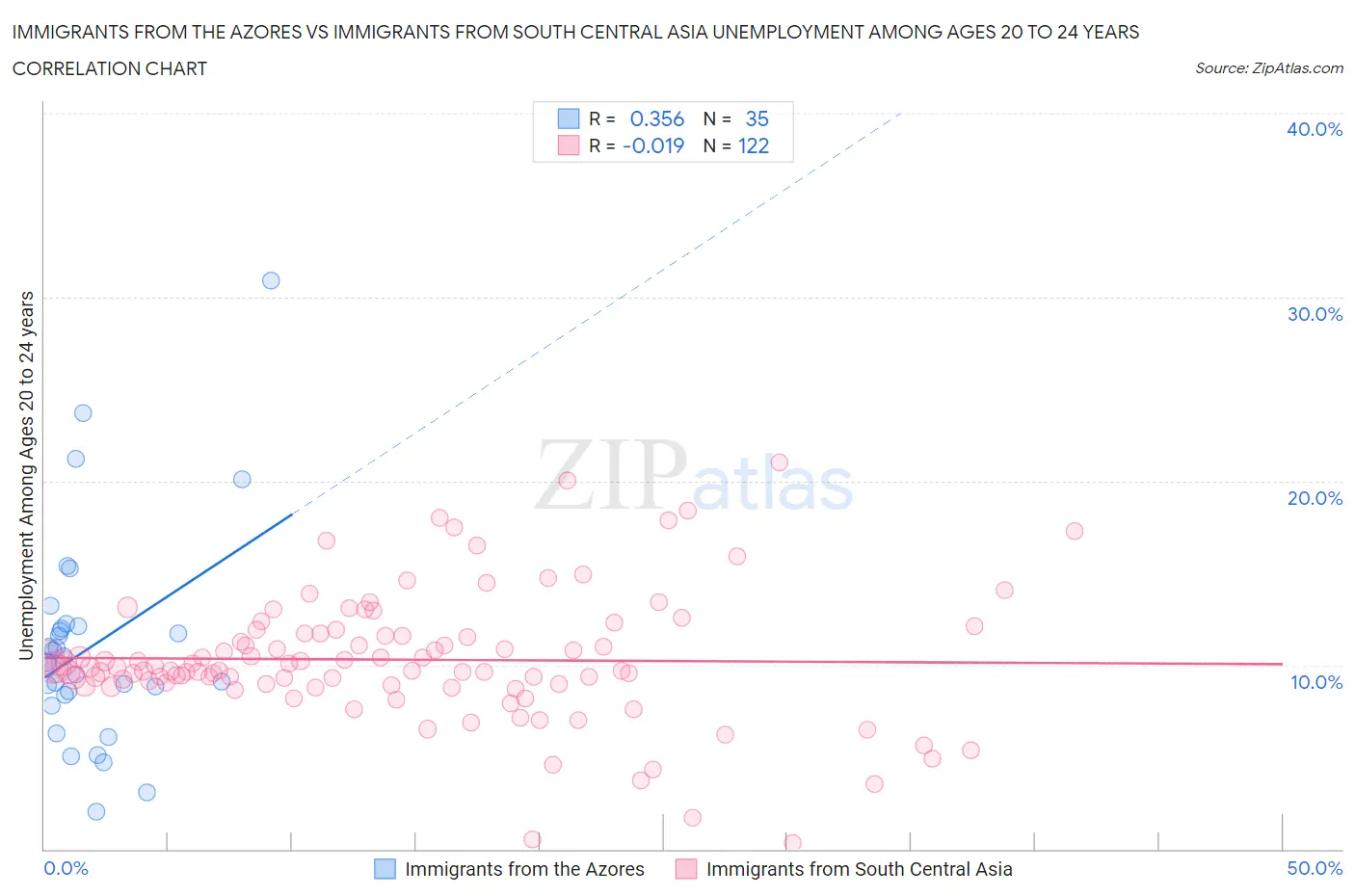Immigrants from the Azores vs Immigrants from South Central Asia Unemployment Among Ages 20 to 24 years
COMPARE
Immigrants from the Azores
Immigrants from South Central Asia
Unemployment Among Ages 20 to 24 years
Unemployment Among Ages 20 to 24 years Comparison
Immigrants from the Azores
Immigrants from South Central Asia
10.2%
UNEMPLOYMENT AMONG AGES 20 TO 24 YEARS
81.4/ 100
METRIC RATING
141st/ 347
METRIC RANK
10.1%
UNEMPLOYMENT AMONG AGES 20 TO 24 YEARS
84.6/ 100
METRIC RATING
129th/ 347
METRIC RANK
Immigrants from the Azores vs Immigrants from South Central Asia Unemployment Among Ages 20 to 24 years Correlation Chart
The statistical analysis conducted on geographies consisting of 45,705,987 people shows a mild positive correlation between the proportion of Immigrants from the Azores and unemployment rate among population between the ages 20 and 24 in the United States with a correlation coefficient (R) of 0.356 and weighted average of 10.2%. Similarly, the statistical analysis conducted on geographies consisting of 454,671,108 people shows no correlation between the proportion of Immigrants from South Central Asia and unemployment rate among population between the ages 20 and 24 in the United States with a correlation coefficient (R) of -0.019 and weighted average of 10.1%, a difference of 0.21%.

Unemployment Among Ages 20 to 24 years Correlation Summary
| Measurement | Immigrants from the Azores | Immigrants from South Central Asia |
| Minimum | 2.0% | 0.30% |
| Maximum | 30.9% | 21.0% |
| Range | 28.9% | 20.7% |
| Mean | 11.0% | 10.3% |
| Median | 10.2% | 9.8% |
| Interquartile 25% (IQ1) | 8.4% | 9.0% |
| Interquartile 75% (IQ3) | 12.1% | 11.7% |
| Interquartile Range (IQR) | 3.7% | 2.7% |
| Standard Deviation (Sample) | 5.8% | 3.5% |
| Standard Deviation (Population) | 5.7% | 3.5% |
Demographics Similar to Immigrants from the Azores and Immigrants from South Central Asia by Unemployment Among Ages 20 to 24 years
In terms of unemployment among ages 20 to 24 years, the demographic groups most similar to Immigrants from the Azores are Immigrants from Austria (10.2%, a difference of 0.0%), Uruguayan (10.2%, a difference of 0.030%), Burmese (10.2%, a difference of 0.060%), Immigrants from Northern Africa (10.2%, a difference of 0.070%), and Immigrants from North America (10.2%, a difference of 0.070%). Similarly, the demographic groups most similar to Immigrants from South Central Asia are Immigrants from Brazil (10.1%, a difference of 0.020%), Immigrants from Lithuania (10.1%, a difference of 0.030%), Seminole (10.1%, a difference of 0.030%), Immigrants from South Eastern Asia (10.1%, a difference of 0.040%), and Immigrants from Norway (10.1%, a difference of 0.050%).
| Demographics | Rating | Rank | Unemployment Among Ages 20 to 24 years |
| Spanish | 86.1 /100 | #125 | Excellent 10.1% |
| Jordanians | 86.1 /100 | #126 | Excellent 10.1% |
| Immigrants | Norway | 85.3 /100 | #127 | Excellent 10.1% |
| Immigrants | Brazil | 84.9 /100 | #128 | Excellent 10.1% |
| Immigrants | South Central Asia | 84.6 /100 | #129 | Excellent 10.1% |
| Immigrants | Lithuania | 84.2 /100 | #130 | Excellent 10.1% |
| Seminole | 84.2 /100 | #131 | Excellent 10.1% |
| Immigrants | South Eastern Asia | 84.0 /100 | #132 | Excellent 10.1% |
| Austrians | 83.9 /100 | #133 | Excellent 10.2% |
| Romanians | 83.8 /100 | #134 | Excellent 10.2% |
| Comanche | 83.4 /100 | #135 | Excellent 10.2% |
| Immigrants | Northern Africa | 82.5 /100 | #136 | Excellent 10.2% |
| Immigrants | North America | 82.5 /100 | #137 | Excellent 10.2% |
| Burmese | 82.3 /100 | #138 | Excellent 10.2% |
| Uruguayans | 81.9 /100 | #139 | Excellent 10.2% |
| Immigrants | Austria | 81.4 /100 | #140 | Excellent 10.2% |
| Immigrants | Azores | 81.4 /100 | #141 | Excellent 10.2% |
| Slovaks | 80.2 /100 | #142 | Excellent 10.2% |
| Immigrants | Jordan | 79.0 /100 | #143 | Good 10.2% |
| Brazilians | 78.4 /100 | #144 | Good 10.2% |
| Argentineans | 78.0 /100 | #145 | Good 10.2% |